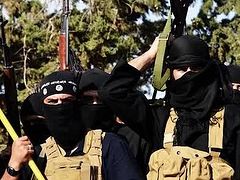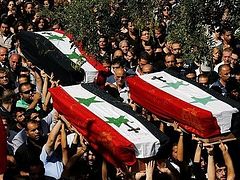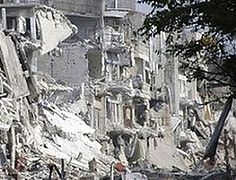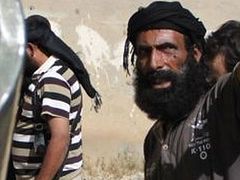SOURCE: The Atlantic
 Free Syrian Army fighters walk along a street in Deir al-Zor that has been scarred by war. Photo: Khalil Ashawi/Reuters
Free Syrian Army fighters walk along a street in Deir al-Zor that has been scarred by war. Photo: Khalil Ashawi/Reuters William R. Polk first wrote for The Atlantic during the Eisenhower administration, with a report in 1958 about tensions in Iraq. Soon after that, he was recruited from a teaching position at Harvard to work on the State Department’s Policy Planning staff in the Kennedy administration. In the years since, he has written and taught extensively about international affairs, especially in the Middle East.
Earlier this year, Polk wrote a series of very widely read dispatches for our site about U.S. policy toward Afghanistan and Syria. He also has two new books available on Amazon. The first, Humpty Dumpty: The Fate of Regime Change, deals with the history and current affairs of Kashmir, Pakistan, Afghanistan, Iran, Syria, Libya, and Mali. The second is an espionage novel called Blind Man's Buff and carries the tale of the Great Game for control of Central Asia into the present. (I have just bought it on Amazon and will report back after reading it.)
Now he offers an updated report on the grim prospects in Syria. Like his previous offerings, it is long and detailed—but as with the others, it offers both a coherent perspective and a myriad of facts and insights you will not find elsewhere. —James Fallows
Geographical Syria
Syria is a small, poor, and crowded country. On the map, it appears about the size of Washington state or Spain, but only about a quarter of its 185,000 square kilometers is arable land. That is, “economic Syria” is about as large as a combination of Maryland and Connecticut or Switzerland. Most is desert—some is suitable for grazing but less than 10 percent of the surface is permanent cropland.
Except for a narrow belt along the Mediterranean, the whole country is subject to extreme temperatures that cause frequent dust storms and periodic droughts. Four years of devastating drought from 2006 to 2011 turned Syria into a land like the American “dust bowl” of the 1930s. That drought was said to have been the worst ever recorded, but it was one in a long sequence: Just in the period from 2001 to 2010, Syria had 60 “significant” dust storms. The most important physical aspect of these storms, as was the experience in America in the 1930s, was the removal of the topsoil. Politically, they triggered the civil war.
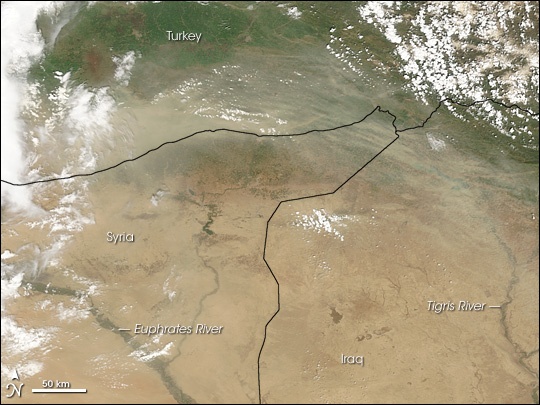 In this 2010 NASA satellite image, vast dust storms can be seen dispersing the light soils of Syria. (NASA)
In this 2010 NASA satellite image, vast dust storms can be seen dispersing the light soils of Syria. (NASA) In addition to causing violent dust storms, high temperatures cause a lessening of rainfall. This U.S. National Oceanic and Atmospheric Administration map of the Mediterranean shows the drought conditions of 2010. Except for small areas of Israel, Jordan, and Lebanon, the whole eastern Mediterranean was severely affected (shown in red).
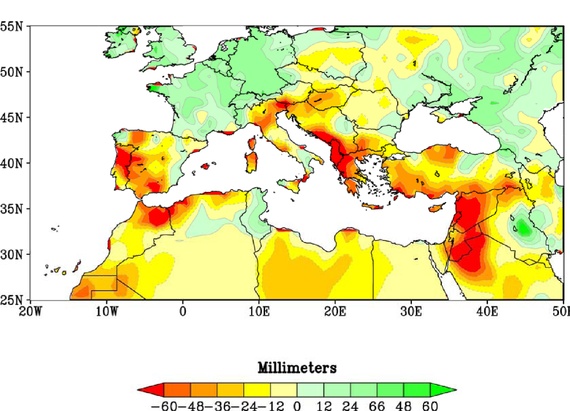 U.S. National Oceanic and Atmospheric Administration
U.S. National Oceanic and Atmospheric Administration Even the relatively favored areas had rainfall of just 20 to 40 centimeters (8 to 15 inches)—where 20 centimeters (8 inches) is regarded as the absolute minimum to sustain agriculture—and the national average was less than 10 centimeters (4 inches). Worse, rain falls in Syria mainly in the winter months when it is less beneficial for crops. Thus, areas with less than 40 centimeters are heavily dependent upon irrigation. Ground water (aquifers) have been so heavily tapped in recent years that the water table in many areas has fallen below what a farmer can access, while the country’s main river, the Euphrates, is heavily drawn down by Turkey and Iraq. Consequently, as of the last year before the civil war, only about 13,500 square kilometers could be irrigated.
Last year, according to the World Bank, agriculture supplied about 20 percent of national income (GDP) and employed about 17 percent of the population. Before the heavy fighting began, Syrian oil fields produced about 330,000 barrels per day, but Syrians consumed all but about 70,000 of that amount. Sales supplied about 20 percent of GDP and a third of export earnings. Production subsequently fell by at least 50 percent, according to the U.S. Energy Information Administration. Syria’s oil is of poor quality, sour, and expensive to refine. Industry, (mainly energy-related) employed about a third of the adult male population and provided a similar percentage of the national income. Before the war, moves were being made to transport oil and gas from farther east across Syria to the Mediterranean; obviously, these projects have been stopped. Now there is a sort of cottage industry in crude refining of petroleum products for local use and smuggling.
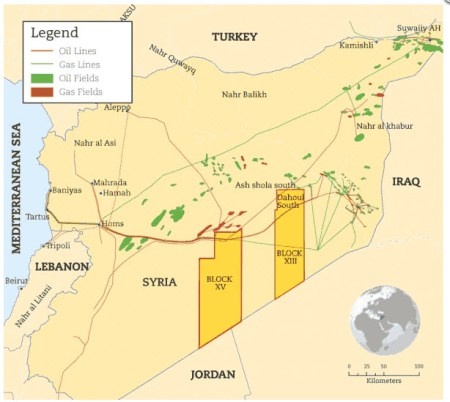 U.S. Energy Information Administration, from Tri-Ocean Energy
U.S. Energy Information Administration, from Tri-Ocean Energy Syria is not just a piece of land; it is densely populated. When I first visited Syria in 1946, the total population was less than 3 million. In 2010, it reached nearly 24 million. Thus, the country offered less than 0.25 hectares (just over a third of an acre) of agricultural land per person. Considering only “agricultural Syria,” the population is about five times as dense as Ohio or Belgium, but it does not have Ohio’s or Belgium’s other means of generating income. If the population were much smaller, Syria could have managed adequately but not, of course, richly.
The bottom line is that the population/resource ratio is out of balance. While there has been a marginal increase of agricultural land and more efficient cropping with better seed, neither has kept up with population growth. Moreover, as the number of people in the country has increased, they have been unable to agree on how to divide what they have. So it is important to understand how their “social contract”—their view of their relationship with one another and with the government—evolved and then shattered.
The Syrian Heritage
Since before history was written, Syria has been fought over by foreign empires—Egyptians, Hittites, Assyrians, Persians, Macedonian Greeks, Romans, Mongols, Turks, British, and French. Only during the Umayyad Caliphate in the 7th and 8th centuries A.D. was it the center of an empire. But that relatively short period left Syria with its Islamic heritage. For many centuries, the society has been overwhelmingly Muslim.
Syria also has historically been a sanctuary for little groups of peoples whose differences from one another were defined in religious and/or ethnic terms. Several of these communities were “leftovers” from previous invasions or migrations. During most of the last five centuries, when what is today Syria was part of the Ottoman Empire, groups of Orthodox, Catholic, and other Christians; Alawis, Ismailis, and other sorts of Shia Muslims; and Yazidis, Kurds, Jews, and Druze lived in enclaves and in neighborhoods in the various cities and towns alongside Sunni Muslim Arabs.
During Ottoman rule the population was organized in two overlapping ways. First, there was no “Syria” in the sense of a nation-state, but rather provinces (Turkish: pashaliqs) that were centered on the ancient cities. The most important of these were Damascus, which may be the oldest permanently settled city in the world today, and Aleppo. The concept of a state, much less a nation-state, did not enter into political thought until the end of the 19th century. Inhabitants of the various parts of what became Syria could move without feeling or being considered alien from one province of the Ottoman Empire to the next. Thus, if the grandfathers or great grandfathers of people alive today were asked about what entity they belonged to, they would probably have named the city or village where they paid their taxes.
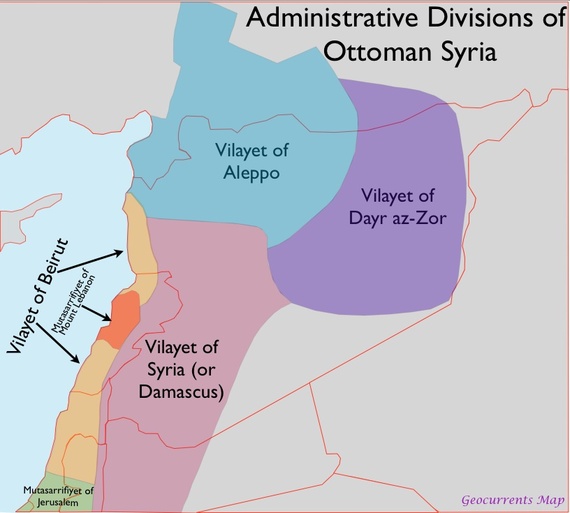 Martin W. Lewis/GeoCurrents
Martin W. Lewis/GeoCurrents Second, throughout its centuries of rule, the Ottoman Empire generally was content to have its subjects live by their own codes of behavior. It did not have the means or the incentive to intrude into their daily lives. Muslims, whether Turk or Arab or Kurd, shared with the imperial government Islamic mores and law. Other ethnic/religious “nations” (Turkish: millet) were self-governing except in military and foreign affairs. The following map is modern but shows approximately the traditional distribution of minority groups in enclaves scattered throughout the area that became Syria.
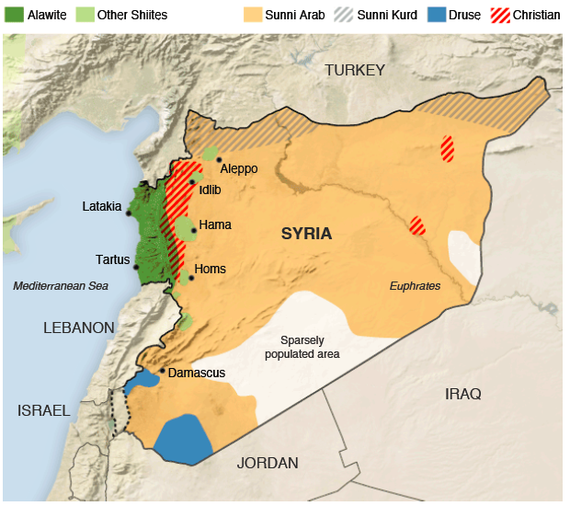 Columbia University Gulf 2000 Project/Bill Marsh and Joe Burgess
Columbia University Gulf 2000 Project/Bill Marsh and Joe Burgess What the map does not show is that the same groups also moved into mainly Muslim cities and towns, where they tended to live in more or less segregated neighborhoods that resembled medieval European urban ghettos or modern American “Little Italys” or “Chinatowns.”
Whether in enclaves or in neighborhoods, each non-Muslim community dressed according to its custom, spoke its own languages, and lived according to its unique cultural pattern; it appointed or elected its own officials, who divided the taxes it owed to the empire, ran its schools, and provided such health facilities and social welfare as it thought proper or could afford. Since this system was spelled out in the Quran and the Traditions (Hadiths) of the Prophet, respecting it was legally obligatory for Muslims. Consequently, when the Syrian state took shape, it inherited a rich, diverse, and tolerant social tradition.
French Syria
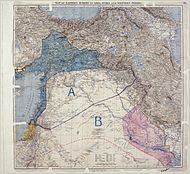
During the latter part of the war, the leaders of the Arab revolt against the Ottoman Empire established a kingdom at Damascus and at the Paris Peace Conference sought recognition of their independence. France was determined, however, to effect its deal with Britain, so in 1920 it invaded and “regime-changed” the Damascus government, making Syria a de facto colony of France but legally, under the League of Nations, a “mandate.” The terms of the League mandate required France to prepare it for independence, but the French showed little intention to do that. They spent the next three years actually conquering the country and reformulating the territory.
First, the French created a “Greater” Lebanon from the former autonomous adjunct provinces (Turkish: sanjaqs) of Mount Lebanon and Beirut. To make it their anchor in an otherwise hostile Levant, they aimed both to make it Christian-dominated and big enough to exist as a state. But these aims were incompatible: the populations they added, taken from the pashaliq of Damascus, were mainly Muslim, so the French doomed Lebanon to be a precariously unbalanced society. Then they split Syria into detached administrative units: In 1921, they separated Alexandretta, in the northwest, and later ceded it to Turkey (where it was renamed Hatay); they split off the hinterland of the port of Latakia, a partly Alawi area, and in 1922 briefly made it a separate state; and they made the Druze area (Jabal ad-Druze) in the southwest an autonomous part of their colony. Finally, they divided the two major cities, Damascus and Aleppo, making each the capital of its neighborhood.
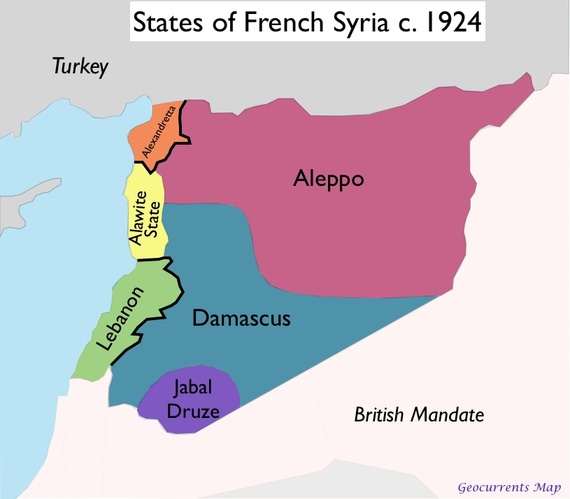 Martin W. Lewis/GeoCurrents
Martin W. Lewis/GeoCurrents None of these divisions worked, so the French reversed course. They united the country as defined in the mandate but attempted to change its social and cultural orientation. Their new policy aimed to supplant the common language, Arabic, with French, to make French customs and law the exemplar, to promote Catholicism as a means to undercut Islam, and to favor the minorities as a means to control the Muslim majority. It was inevitable that the native reaction to these intrusions would be first the rise of xenophobia and then the spread of what gradually became a European style of nationalism. It is thus in the 1920s and 1930s that we can begin to speak of the concept of Syrian statehood. Indeed, a sense of statehood and nationhood were the major ideas that emerged from the First World War and were popularized during the period of French rule.
When French policies did not work and nationalism began to offer an alternate vision of political life, the French colonial administration fell back on violence. Indeed throughout the French period—in contrast to the relatively laissez-faire rule of the Ottoman Empire—violence was never far below the outward face of French rule. The French bombarded Damascus, which they had regime-changed in 1920, in 1925, 1926, and 1945, and they pacified the city with martial law during most of the “peaceful” intervals. Constitutions were proclaimed periodically, only to be revoked, and independence was promised time after time until it was finally gained—not by the Syrians nor given by the French but bestowed on Syria by the British army. Because the French administration was under the control of the Vichy government and had abetted German activities, the British invaded in 1941 and overthrew Vichy France’s administration. However, they left behind the “Free French” who continued essentially the Vichy regime. The last French soldier did not leave until April 17, 1946, which became Syria’s national day.
It is not unfair to characterize the impact of the 26 years of French rule thus: the “peace” the French achieved was little more than a sullen and frustrated quiescence; while they did not create dissension among the religious and ethnic communities, the French certainly magnified it and while they did not create hostility to foreigners, they gave the native population a target that fostered the growth of nationalism. These developments have lingered throughout the last 70 years and remain powerful forces today.
Syrian Independence
As it took hold of at least educated Syrians, nationalism may have been emotionally satisfying, but it did not prove to be an organizing principle. Even spurred by it, Syrians did not grasp the means to control their destiny. So, in the years after the French were forced out, coup leader after military dictator spoke in nationalist rhetoric but failed to lead his followers toward “the good life.” Finally, in 1958, the one coherent, powerful, and mobile force, the army leadership, threw the country into the arms of the one Arab leader they admired and trusted, Egypt’s President Gamal Abdel Nasser. They thought and hoped that Egypt, always the bellwether of the Arab world, could give them stability. So, for three and a half years, Syria became a part of the United Arab Republic. Despite the media view of the event, Nasser was a reluctant participant in Syrian affairs and set what turned out to be unacceptable terms, including the withdrawal of the army from politics and the holding of a referendum. Union did not work, so in 1961 Syrians were thrown back on their own resources. A fundamental problem they faced was what it meant to be a Syrian.
The majority of those who became Syrians were Arabic-speaking Sunni Muslims. Since the road to worldly success was through the Arabic-speaking army or bureaucracy, Syrians, like the inhabitants of empires throughout Asia, found conversion to Islam and becoming Arabic-speaking—if they were not already members of this community—attractive. The earliest estimates we know suggest that between seven and eight in 10 Syrians saw themselves as Muslim Arab—and, under the growing influence of nationalism, saw being a Muslim Arab as the very definition of Syrian identity.
What was unusual about Syria was that the other two or three in 10 Syrians did not feel the same way. As in Ottoman times, they continued to live in economically autarkic areas of the countryside and in quarters of most of the cities and towns of the country. Nationalists took this diversity as a primary cause of weakness and adopted as their primary task integrating the population into a single political and social structure.
But the nationalists were deeply split. The major Islamic movement, the Muslim Brotherhood, argued and fought for the idea that the nation must be Arab Sunni (or “Orthodox”) Muslim. Minorities had no place except in the traditional and Ottoman sense of “protected minorities.” The more conservative, affluent, and Westernized nationalists believed that nationhood had to be built not on a religious but on a territorial base. That is, single-state nationalism (Arabic:wataniyah) was the focus of Syria’s statehood. Their program, however, did not lead to success; its failure opened the way for a redefinition of nationalism as pan-Arab or folk nationalism (Arabic: qawmiyah). As it was codified by the Baath Party, it required that Syria be considered not a separate nation-state but a part of the whole Arab world and be domestically organized as a unified, secular, and at least partly Westernized state. This was a particularly difficult task because the dominant Muslim community, initially as a result of French rule and later as a result of domestic turbulence and foreign interference, regarded the members of the minority communities, particularly the Jewish community, as actual or potential turncoats.
Looming over Syrian politics and heightening the tensions among the contenders for dominance throughout the post-war period has been the modern, powerful, and American-supported state of Israel; regular wars between Syria and Israel began in 1948, almost before either state had achieved full independence, and were repeated in 1967 and 1973. Border clashes, informal fighting, and limited ceasefires were interspersed among these major confrontations. And since 1967, Israel has occupied the 1,200 square kilometers (460 square miles) of Syrian territory known as the Golan Heights. In 1981, Israel proclaimed that it had annexed the territory, a move not recognized by the U.S. or other states, and moved nearly 20,000 settlers there. Meanwhile, intermittent peace talks have been secretly held from time to time without result. A ceasefire, negotiated in 1974, has held, but today the two states are still legally at war.
The Assad Regime
It was in answer to the perceived weakness of Syrian statehood and the disorder of Syrian political life that the first Assad regime was established in 1970 by Hafez al-Assad, the father of the current leader. The Assad family came from the Alawi (a.k.a. Nusairi) minority, which includes about one in eight Syrians and about a quarter of a million people in both Lebanon and Turkey. Like the Jews, the Alawis consider themselves the “chosen people,” but they are regarded by Orthodox Muslims as heretics. Under Ottoman pluralism, this mattered little, but as Syrians struggled for a sense of identity and came to suspect social difference and to fear the cooperation of minorities with foreigners, being an Alawi or a Christian or a Jew put people under a cloud. So, for Hafez al-Assad, the secular, nationalist Baath Party was a natural choice: it offered, or seemed to offer, the means to overcome his origins in a minority community and to point toward a solution to the disunity of Syrian politics. He therefore embraced it eagerly and eventually became its leader. Consequently, to understand Syrian affairs, we need to focus on the party.
Thus, Saddam became as much the ogre in the bestiary of Hafaz al-Assad as he later became in America’s.
The “Resurrection” (Arabic: Baath) Party had its origins, like the nationalist-communist Vietnamese movement, in France. Two young Syrians, one a Christian and the other a Sunni Muslim, who were then studying in Paris were both attracted to the grandeur of France and appalled by the weakness of Syria. Like Ho Chi Minh, they wanted to both become like France and get the French out of their nation. Both believed that the future lay in unity and socialism. For Michel Aflaq and Salah Bitar, the forces to be defeated were “French oppression, Syrian backwardness, a political class unable to measure up to the challenge of the times,” according to the British journalist Patrick Seale’s account in The Struggle for Syria. Above all, disunity had to be overcome. Their answer was to try to bridge the gaps between rich and poor through a modified version of socialism, and between Muslims and minorities through a modified concept of Islam. Islam, in their view, needed to be considered politically not as a religion but as a manifestation of the Arab nation. Thus, the society they wished to create, they proclaimed, should be modern (with, among other things, equality for women), secular (with faith relegated to personal affairs), and defined by a culture of “Arabism” overriding the traditional concepts of ethnicity. In short, what they sought was the very antithesis of the objectives of the already-strong and growing Muslim Brotherhood.
Like the Muslim Brotherhood, the Baath Party spread among young students. When, as a young student myself, I visited Syria in 1950, I was astonished at how vigorous the student political movements were and how seriously, even violently, the students played a national role. Hafez al-Assad was one of the first student recruits of what would become the Baath Party, and quickly became a local hero for his dedication to its cause. As Seale describes, “He became a party stalwart, defending its cause on the street … he was one of our commandos.” And he almost paid with his life for his bravery when a Muslim Brother stabbed him. So, pardon the pun, his antipathy to the Muslim Brotherhood began early and went deep.
Like many young men of his generation, Hafez al-Assad first put his hopes in the military, which seemed, more than political parties, even the Baath, to embody the nation. He avidly studied his new profession and became a fighter pilot, but he quickly realized that the military was only a means of action and that what it did had to be guided by political ideas and organization. So, he used his military affiliation to energize his party role. This, inevitably, caught him up in the coups, counter-coups, and sundry conspiracies that engaged Syrian politicians and army officers during the 1950s and 1960s. Emerging from this labyrinth, he skillfully maneuvered himself into the leadership of his party and domination of the political and military structure of the country by 1971. And his assumption of the presidency was certified by a plebiscite in that year.
His survival, much less his victory, was nearly a miracle, but he had not managed to solve the fundamental problem of Syrian ethnicity and particularly the role of Islam in society.
This problem, which is so tragically and bitterly evident in Syria today, found an early expression in the writing of the new constitution in 1973. The previous constitutions, going back to French colonial times, had specified that a Muslim should hold the presidency. Despite his dedication to secular politics, Hafez al-Assad made two attempts to cater to Muslim opinion. In the first, he got the clause in the former constitutions conditioning the presidential office to a Muslim replaced by a redefinition of Islam of sorts. “Islam,” the new language stressed, “is a religion of love, progress and social justice, of equality for all…” Then, in the second move, he arranged for a respected Islamic jurisconsult (not from Syria but from Lebanon, and not a Sunni but a Shia) to issue a finding (Arabic: fatwa) that Alawis were really Shia Muslims rather than heretics. This was not merely an abstract bit of theology: as heretics, Alawis were outlaws who could be legally and meritoriously killed—as we have seen in recent events in Syria.
The Muslim Brotherhood was furious. Riots broke out around the country, particularly in the city of Hama. For some years, Assad managed to contain the discontent—partly by granting subsidies on food and partly by curbing the already-hated political police—but the fundamental issue was not resolved. Muslim Brothers and other disaffected groups organized terrorist attacks on the government and on Assad’s inner circle, killing some of his close collaborators and exploding car bombs at installations, including even the office of the prime minister and the headquarters of the air force. Assad was told that he would soon follow Egypt’s Anwar Sadat, killed by Muslim terrorists, into the grave. As it had been periodically during French colonialism, the whole city of Damascus came under siege. Finally, the Islamic forces were ready to challenge the regime in all-out war. An army unit sent into the Muslim Brotherhood stronghold in the city of Hama was ambushed. The local Muslim guerrilla leader gave the signal for a general uprising. Overnight the city was engulfed in a vicious, “no-prisoners” insurrection. The regime was fighting for its life. As Patrick Seale, the most astute observer of those events, has written, in words that also ring true for the events of 2013:
Fear, loathing and a river of spilt blood ruled out any thought of truce … that explain[s] the terrible savagery of the punishment inflicted on the city. Behind the immediate contest lay the old multi-layered hostility between Islam and the Ba’th, between Sunni and ‘Alawi, between town and country…. Many civilians were slaughtered in the prolonged mopping up, whose districts razed, and numerous acts of savagery reported…. Government forces too suffered heavy losses to snipers and many armoured vehicles were hit by grenades in the rubble-strewn streets … between 5,000 and 10,000 [people died].
After Assad’s assault in 1982, the Syrian city of Hama looked like the Iraqi city of Fallujah after the American assault in 2004. Acres of the city were submerged under piles of rubble. But then, like Stalingrad after the German attack or Berlin after the Russian siege, reconstruction began. In a remarkable series of moves, Hafez al-Assad ordered the rubble cleared away, built new highways, constructed new schools and hospitals, opened new parks, and even, in a wholly unexpected conciliatory gesture, erected two huge new mosques. He thus made evident what had been his philosophy of government since he first took power: help the Syrian people to live better provided only that they not challenge his rule. In his thought and actions, his stern and often-brutal monopoly of power, he may be compared to the ruling men, families, parties, and establishments of Chinese, Iranian, Russian, Saudi Arabian, Vietnamese, and numerous other regimes.
Also like many of those regimes, Assad saw foreign troublemakers at work among his people. This, after all, was the emotional and political legacy of colonial rule—a legacy painfully evident in most of the post-colonial world, but one that is almost unnoticed in the Western world. And the legacy is not a myth. It is a reality that, often years after events occur, we can verify with official papers. Hafez al-Assad did not need to wait for leaks of documents: his intelligence services and international journalists turned up dozens of attempts by conservative, oil-rich Arab countries, the United States, and Israel to subvert his government. Most engaged in “dirty tricks,” propaganda, or infusions of money, but it was noteworthy that in the 1982 Hama uprising, more than 15,000 foreign-supplied machine guns were captured, along with prisoners including Jordanian- and CIA-trained paramilitary forces (much like the jihadists who appear so much in media accounts of 2013 Syria). And what he saw in Syria was confirmed by what he learned about Western regime-changing elsewhere. He certainly knew of the CIA attempt to murder President Nasser of Egypt and the Anglo-American overthrow of the government of Iranian Prime Minister Mohammad Mosaddegh.
His salvation, he believed, lay in his political party, the Baath. But even that fell apart. While it was the titular ruling party of both Syria and Iraq, its leaders became bitterly hostile to one another over what in retrospect seem mainly personal issues but which, at the time, appeared to be cultural and ideological. As Iraq “imploded” in coups beginning in 1958 and morphed into Saddam Husain’s regime, the Syrians came to regard it as an enemy second only to Israel. Already in 1980, Hafez al-Assad sided with Iran in the Iran-Iraq war. His choice was confirmed when he learned that America was supplying both up-to-the-minute satellite intelligence to Saddam’s forces and the chemicals with which the Iraqis manufactured poison gas to attack the Iranians. Assad took this as proof that somehow Saddam had become an American agent. Thus, Saddam became as much the ogre in the bestiary of Hafaz al-Assad as he later became in America’s. This explains why, in 1991, when Iraq invaded Kuwait, Hafez al-Assad sided with the American-led, anti-Saddam coalition.
As in the Afghan war against the Russians, the insurgents are split into mutually hostile groups. This has made them impossible to defeat.
The second (Bashar) al-Assad regime began when Hafez al-Assad died in 2000. Like his father had done after the Battle of Hama, Bashar initially made conciliatory moves to his opponents, including allowing the Muslim Brotherhood to resume political activities and withdrawing most of the Syrian troops that had occupied strife-torn Lebanon. But, while he legitimized his position through an election, he quickly showed that he was also following his father’s authoritarian path: ‘Run your own lives privately and enrich yourselves as you wish, but do not challenge my government.’
During the rule of the two Assads, Syria made considerable progress. By the eve of the civil war, Syrians enjoyed an income (GDP) of about $5,000 per capita. That was nearly the same as Jordan’s, roughly double the income per capita of Pakistan and Yemen, and five times the income of Afghanistan, but it is only a third that of Lebanon, Turkey, or Iran, according to the CIA World Factbook. In 2010, savaged by the great drought, GDP per capita had fallen to about $2,900, according to UN data. Before the civil war—and except in 2008 at the bottom of the drought, when it was zero—Syria’s growth rate hovered around 2 percent, according to the World Bank. In social affairs, nearly 90 percent of Syrian children attended primary or secondary schools and between eight and nine in 10 Syrians had achieved literacy. On these measures, Syria was comparable to Iran, Saudi Arabia, and Libya despite having far fewer resources to employ. The most important issue on which the Assad regimes made little or no progress was birth control, which as I have mentioned threw out of balance resources and population.
Like his father, Bashar sought to legitimize his regime through elections, but apparently he never intended, and certainly did not find, a way satisfactory (to the public) and acceptable (to his regime) of enlarged political participation. While this has been the focus of most foreign hostility to his regime, it was certainly less important to Syrians than his failure to find any means of bridging the gap between the demands of Islam and the new role of the Alawi community. This failure was to play havoc with Syrian affairs. The lack of political participation, fear of public demands, and severe police measures made the regime appear to be a tyranny. This and its hostility to Israel led to large-scale, if covert, attempts at regime change by outside powers including the United States. These acts of subversion became particularly pronounced during the second Bush administration.
Pre-War Syrian Foreign Relations
The Bush administration signaled a new anti-Syrian policy in 2002 when the president included it in what he proclaimed to be the “Axis of Evil.” Covert activities were stepped up and, the following year, Bush threatened to impose sanctions (which he did impose two years later). In 2003, Israel used American aircraft in a strike on a Palestinian refugee camp just outside of Damascus. It was the first of a sequence of humiliating attacks that the Syrian armed forces were unable to prevent. The American Congress rubbed salt into that wound by passing the Syria Accountability Act, which charged the Syrians with supporting terrorism and occupying much of Lebanon as well as seeking chemical weapons.
The foreign jihadists put their emphasis on a larger-than-Syria range. For them, it is a folk nationalism not only to the Arab world but also to the wider world of Islam.
At the same time, diplomatic moves were made to reduce tensions. In 2006, relations were resumed between Syria and Iraq (by then under an American-imposed Shia government; the two countries remain cordial today). In 2007, senior EU and U.S. officials, in an informal version of recognition, visited Damascus, while Syria, seeking to end its split with conservative Arab governments, hosted an Arab League meeting. But the issue of weapons of mass destruction quickly soured these demarches, particularly when it came to relations between the U.S. and Syria. In a still-controversial charge that North Korea was building a nuclear weapons facility at a remote northern site, Israel again bombed Syria in 2007. But six months later, French President Nicolas Sarkozy invited al-Assad to Paris to work toward re-establishing diplomatic relations.
Tensions were then once more eased with high-level visits and, in 2010, the U.S. sent an ambassador to Syria. Three months later, however, Washington imposed new sanctions on the country. The sanctions aimed to diminish government revenues, particularly from oil exports, and to increase public opposition to the regime. The Syrian regime had not changed, but there seemed to be no clear or consistent policy by the U.S. or the EU toward it.
The Civil War Breaks Out
Four years of devastating drought beginning in 2006 caused at least 800,000 farmers to lose their entire livelihood and about 200,000 simply abandoned their lands, according to the Center for Climate & Security. In some areas, all agriculture ceased. In others, crop failures reached 75 percent. And generally as much as 85 percent of livestock died of thirst or hunger. Hundreds of thousands of Syria’s farmers gave up, abandoned their farms, and fled to the cities and towns in search of almost non-existent jobs and severely short food supplies. Outside observers including UN experts estimated that between 2 and 3 million of Syria’s 10 million rural inhabitants were reduced to “extreme poverty.”
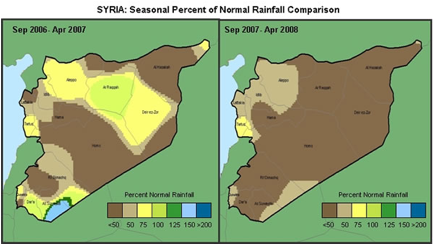 U.S. Department of Agriculture Foreign Agricultural Service
U.S. Department of Agriculture Foreign Agricultural Service As they flocked into the cities and towns seeking work and food, the “economic” or “climate” refugees immediately found that they had to compete not only with one another for scarce food, water, and jobs, but also with the existing foreign refugee population. Syria was already a refuge for a quarter of a million Palestinians and about 100,000 Iraqis who had fled the war and occupation. Formerly prosperous farmers were lucky to get jobs as hawkers or street sweepers. And in the desperation of the times, hostilities erupted among groups that were competing just to survive.
Survival was the key issue. The senior UN Food and Agriculture Organization representative in Syria turned to the USAID program for help. Terming the situation “a perfect storm,” in November 2008 he warned that Syria faced “social destruction.” He noted that the Syrian minister of agriculture had “stated publicly that [the] economic and social fallout from the drought was ‘beyond our capacity as a country to deal with.’” His appeal fell on deaf ears: the USAID director commented that “we question whether limited USG resources should be directed toward this appeal at this time,” according to a cable obtained by WikiLeaks.
Whether or not USAID made a wise decision, we now know that the Syrian government had set itself up for catastrophe. Lured by the high price of wheat on the world market, it had sold its strategic reserves in 2006. According to the U.S. Department of Agriculture, in 2008 and for the rest of the drought years it had to import enough wheat to keep its citizens alive.
The senior UN Food and Agriculture Organization representative in Syria termed the situation “a perfect storm.”
And so tens of thousands of frightened, angry, hungry, and impoverished former farmers were jammed into Syria’s towns and cities, where they constituted tinder ready to catch fire. The spark was struck on March 15, 2011, when a relatively small group gathered in the southwestern town of Daraa to protest against government failure to help them. Instead of meeting with the protesters and at least hearing their complaints, the government saw them as subversives. The lesson of Hama must have been at the front of the mind of every member of the Assad regime. Failure to act decisively, Hama had shown, inevitably led to insurrection. Compromise could come only after order was assured. So Bashar followed the lead of his father. He ordered a crackdown. And the army, long frustrated by inaction and humiliated by its successive defeats in confrontation with Israel, responded violently. Its action backfired. Riots broke out all over the country. As they did, the government attempted to quell them with military force. It failed. So, during the next two years, what had begun as a food and water issue gradually turned into a political and religious cause.
The Civil War Takes Shape
While we know a good deal about the Syrian government because it is much like many other governments around the world, we don’t know much about the rebels. Hundreds of groups and factions—called “brigades” even when they are just a dozen or so people—have been identified. Some observes believe that there are actually over 1,000 brigades. A reasonable guess is that, including both part-time and full-time insurgents, they number about 100,000 fighters.
As in the Afghan war against the Russians, the insurgents are split into mutually hostile groups. This has made them impossible to defeat and very difficult to engage in negotiations. In Afghanistan, the Russians won all the battles and occupied the entire country sporadically but could never identify any leadership with which they could negotiate. Indeed, even while fighting the Russians, the Afghan guerrilla groups fought against each other for territory, money, weapons, access to smuggling routes, leadership, old ethnic hatreds, and more. Consequently, despite massive foreign aid, they were never able to defeat the Russians. As we shall see, this pattern has been repeated in Syria. There the war has reached a stalemate in which neither side, regardless of the promise or provision of weapons and money by outside powers, is likely to prevail.
In Afghanistan, the principal cause for the splits among the rebels was largely ethnic: the Tajiks, Turkmen, Hazaras, and Pashtuns, even in the face of mortal dangers, remained bitterly, even murderously, hostile to one another. In Syria, quite different causes of splits among the brigades are evident. To understand the insurgency there, we must look carefully at the causes. The basis is religion.
During the course of the Assad regime, the interpretation of Islam was undergoing a profound change. This was true not only of Syria but also of understanding, practice, and action in many other areas of the world. Particularly affected by the policies of foreigners were young men and women in Iraq, Iran, Afghanistan, Libya, Chechnya, Chinese Turkestan (now Xinjiang), and Egypt.
Millions of Sunni Muslims throughout Africa and Asia—and even some Shia Muslims—have found inspiration in the writings of the fundamentalist Egyptian theologian Sayyid Qutb. Whether or not the governments of their homelands were favorably disposed to Islam, many found the compromises made with modernization or Westernization politically weak or religiously unjustified. Moreover, in areas under non-Muslim rule, such as (Russian-controlled) Chechnya and (Chinese-colonized) Xinjiang, they felt oppressed. Many of those living in the West found that Sayyid Qutb’s denunciation of their lack of spirituality and crass materialism fit their own interpretation. Others began to find the all-too-common discrimination against them in Christian lands intolerable. So it was that tens of thousands of young foreigners flocked to Syria to fight for what they see as a religious obligation (Arabic: fi sabili’llah).
Meanwhile, in Syria, while many Muslims found the Assad regime acceptable and many even joined its senior ranks, others saw its Alawi and Christian affiliations, and even its secularism and openness to Muslim participation, insupportable.
More than 2 million people have fled abroad while more than 4 million are internal refugees, remaining in Syria.
What has happened is that the aims of the two broad groups—the Syrians and the foreigners—have grown apart in a way similar to the split that occurred in Arab nationalism. The Syrians focus on Syria and seek the overthrow of the Assad regime much as their fathers and grandfathers focused on the task of getting the French out of their country—their watan. Their nationalism is single-country oriented. The foreign jihadists, like the more recent nationalists, put their emphasis on a larger-than-Syria range. For them, it is a folk nationalism not only to the Arab world but also to the wider world of Islam, affecting a billion people across the globe. What they seek is a restored Islamic world, a Dar ul-Islam, or a new caliphate.
It might become clearer to Westerners if we think of this split, mutatis mutandis,in terms of Russian affairs: Stalin focused Communism on a single country whereas Trotsky attempted to cause a world revolution. I want to emphasize that this is not a recondite or theoretical point but is of major importance in understanding the current hostilities and will be fundamental in any attempt to negotiate a ceasefire or a lasting settlement.
Having said that, I want also to emphasize that there is no doubt that, however much they disagree among themselves, which they obviously do, all the rebels regard the conflict in Syria as fundamentally a religious issue. Particularly for the native rebels, as I have pointed out, the religious issue is overlaid by ethnic complexities. It would be a mistake to regard the Syrian war, as some outside observers have done, as a fight between the forces of freedom and tyranny. If the opponents of the regime are fighting for some form of democracy, they have yet to make their voices heard.
Like nationalism and socialism in the 1950s and 1960s, Islam has at least so far failed to provide an effective unifying force—what a great Arab historian put simply as “turning their faces in a single direction.” As in other guerrilla wars, the rebels have therefore split into a bewildering array of groups. And, as in Afghanistan, they have fought one another over territory, access to arms, leadership, and division of spoils as bitterly as they have fought their proclaimed enemy. This fracturing has made them impossible to defeat—as the Russians experienced in Afghanistan—but also, so far at least, incapable of governing on a national scale. But they are moving in that direction.
The more radical groups, led by Al-Nusra Front, give the appearance of having studied guerrilla warfare as it occurred elsewhere. Among other things, they have learned that to stay alive, much less to win their battles, guerrillas must earn the support of the people; in areas they control, they provide essential services. Overall, these add up to an alternative government. As the most venturesome and best informed of the foreign media reporters witnessed:
The al-Nusra Front, the principle [sic] jihadi rebel group in Syria, defies the cliche of Islamist fighters around the Middle East plotting to establish Islamic caliphates from impoverished mountain hideaways. In northeastern Syria, al-Nusra finds itself in command of massive silos of wheat, factories, oil and gas fields, fleets of looted government cars and a huge weapons arsenal.
The commander talked about the services al-Nusra is providing to Shadadi's residents. First, there is food: 225 sacks of wheat, baked into bread and delivered to the people every day through special teams in each neighbourhood. Then there is free electricity and water, which run all day throughout the town. There is also al-Nusra healthcare, provided from a small clinic that treats all comers, regardless of whether they have sworn allegiance to the emirate or not. Finally, there is order and the promise of swift justice, delivered according to sharia law by a handful of newly appointed judges.
All observers agree that the foreign-controlled and foreign-constituted insurgent groups are the most coherent, organized, and effective. This is little short of astonishing as they share no common language and come from a wide variety of cultures. In one operation, which I mention below, the cooperating groups were made up of Chechens, Turks, Tajiks, Pakistanis, French, Egyptians, Libyans, Tunisians, Saudi Arabians, and Moroccans.
Paradoxically, governments that would have imprisoned the same activists in their own countries have poured money, arms, and other forms of aid into their coffers. The list is long and surprising in its makeup: it includes Turkey; the conservative Arab states, particularly Qatar and Saudi Arabia; the EU member states; and the U.S.
The United States has a long history of covertly aiding insurgents in Syria, and has engaged in propaganda, espionage, and various sorts of dirty tricks. The rebels, naturally, have regarded the aid they’ve received as insufficient, while the government has regarded it as a virtual act of war. Both are right: it has not been on a scale that has enabled the rebels to win, but it is a form of action that, had another country engaged in it, seeking to overthrow the government, any American or European administration would have regarded as an act of war under international law.
Such covert intervention, and indeed overt intervention, is being justified on two grounds, the first being that the Syrian government is a tyranny. By Western standards, it is undoubtedly an authoritarian regime. Whether or not it gassed hundreds of its citizens, it has certainly killed thousands with conventional weapons. (According to the Syrian Observatory for Human Rights, the rebels are known to have killed at least 20,000 and perhaps as many as 30,000 government soldiers, about twice the number of rebel casualties, and both sides have committed documented atrocities.) However, the standards Western nations proclaim have been applied in a highly selective way. The EU and the U.S. enjoy cordial and mutually beneficial relations with dozens of tyrannical governments including most of the countries now attempting to regime-change Syria.
Secretary of State John Kerry has claimed that only a portion of the rebels—he thinks about 15 to 25 percent—are what he calls “the bad guys.” But observers on the scene point out that this means there are about 15,000 or 25,000 “bad guys,” and that they are very bad indeed. Moreover, in the massacres carried out in September and October this year and investigated by Human Rights Watch, the perpetrators were not just foreign fighters but also native Syrians. In one video, a rebel commander is seen eating the heart of a soldier he has just killed; in another, a group of rebels murder captive soldiers who are bound and lying face down in the ground. Another group recently carried out an attack on an old, established, and peaceful Christian community whose members, incidentally, still speak Aramaic, the language Jesus presumably spoke.
These are not isolated acts. Senior rebels have publicly threatened to carry out a genocide of the country’s main ethnic/religious minority, the Alawis. Scenes being enacted in Syria today recall the massacres and tortures of the wars of religion in 16th- and 17th-century Europe.
The British journalist Jonathan Steele was told by the commander of a village defense force (neither a government soldier nor a rebel) that he saw the results of an attack including “a baby’s head hanging from a tree. There was a woman’s body which had been sliced in half from head to toe and each half was hanging from separate apple trees.” It is difficult even to imagine the well of hatred exemplified by such scenes.
Most urgent in the minds of the EU and the U.S. is the second justification for intervention: the Syrian government is charged with using illegal chemical weapons. This is a very serious charge. However, doubts remain about who actually used the weapons. And, more importantly, even though the weapons are indeed horrible and are now generally considered illegal, several other states (the U.S., Israel, Egypt, and Iraq) have used them. Terrible as they are, they are only a small part of the Syrian problem—more than 99 percent of the casualties and all of the property damage in the war have been the result of conventional weapons. Getting rid of chemical weapons will neither in and of itself stop the war nor create conditions favorable to a settlement.
The Cost of the War
Proportional to Syria’s resources, the cost of the war has been immense. And, of course, it is not over. We have only guesses on the total so far. One estimate is that the war has cost Syria upwards of $150 billion. Whole cities now resemble Stalingrad or Berlin in World War II. More than 2 million people have fled abroad while more than 4 million are internal refugees, remaining in Syria.
We have perhaps more accurate estimates on the cost of the spillover into Lebanon. Even though there is little fighting there, the conflict in Syria is estimated to have cost that little country about $7.5 billion and doubled unemployment to 20 percent. About 1 million Lebanese were already judged by the World Bank as “poor,” and an additional 170,000 are now thought to have been pushed into poverty. The Syrian refugee population in the country has reached at least 1 million, making Syrians now almost a third of the total Lebanese population.
“There was a woman’s body which had been sliced in half from head to toe and each half was hanging from separate apple trees.”
In Jordan, the story is similar. Half a million refugees are camped out there. One refugee encampment in the country houses over 100,000 people and has become Jordan’s fifth-largest city. Nearly as many have fled to Turkey. Tens of thousands more, mainly Kurds, have fled the genocidal attacks of the Syrian rebels and gone to Iraq.
Before the war in Syria began, Syria was itself a refuge for others. As a result of Israeli occupation of formerly Palestinian lands, half a million Palestinians took refuge in Syria. They were followed by more than 100,000 Lebanese who fled the war between Israel and Lebanon. Upwards of 2 million Iraqis fled during the American attack and occupation of their country and about 1 million of them, roughly half of them Christians, went to Syria. As the war in Syria has grown bloodier with massacres and summary executions of Christians and Shia Muslims by Islamic fundamentalists, all but about 200,000 have returned to Iraq. These refugees have been a major drain on the government’s resources.
Tragic as these numbers are—the worst for nearly a century—factored into them is that Syria has lost the most precious assets of poor countries: most of the doctors and other professionals who had been painstakingly and expensively educated during the last century. However reprehensible the Syrian government may be in terms of democracy, it has not only given refugees and minorities protection but also maintained the part of Syria that it controls as a secular and religiously ecumenical state.
The Potential Results of the Syrian War
Even more “costly” are the psychological traumas: a whole generation of Syrians have been subjected to either or both the loss of their homes and their trust in fellow human beings. Others will eventually suffer from the memory of what they, themselves, have done during the fighting. Comparisons are trivial and probably meaningless, but what has been enacted—is being enacted—in Syria resembles the horror of the Japanese butchery of Nanjing in World War II and the massacres in the 1994 Hutu-Tutsi conflict in Rwanda.
Even if fighting dies down, “lasting and bitter war,” like the wars in Iraq and Afghanistan, will necessarily involve “boots on the ground.”
In short, millions of lives have been wrenched out from under the thin veneer of civilization to which we all cling and have been thrown into the bestiality that the great observer of the brutal English civil war of his time, Thomas Hobbes, memorably described as the “state of nature.” That is, unending war, where “every man [is] against every man.” Then the life of all will be “poore, nasty, brutish and short.” How the victims and the perpetrators can be returned to a “normal life” will be the lingering but urgent question of coming generations in Syria and elsewhere.
Elsewhere, one in four or five people in the world today are Muslim: roughly 1.4 billion men, women, and children. That whole portion of the world’s population has its eyes on Syria. What happens there is likely to have a ripple effect across Asia and Africa. Thus, even though it is a small and poor country, Syria is in a sense a focal point of world affairs.
Let us consider what might happen within Syria.
First, the war might continue. It is now at a stalemate and outside powers may continue to keep it that way. As we have seen, they have been the major supporters of the rebels. With or without their help, will the war die down of its own accord? That is, will it run out of fighters and victims? Even at the current horrific rate, that seems unlikely. Will the survivors give up? I think not. Foreign fighters stream in even as refugees pour out. And as we have seen elsewhere, wars can run on “lean.” What’s more, the rebels are driven by a burning faith. So, absent successful negotiations, which the rebels have announced they will not accept, I can see no end.
Second, if the Syrian government continues or even prevails, there is no assurance that, without outside help and an end to foreign aid to the rebels, it will be able to suppress the insurgency. We see clear evidence to the contrary in the experiences of Afghanistan, Iraq, and Libya. Guerrillas can hang on for years as they exhaust their opponents. They need little on which to survive.
Third, if the current stalemate continues, Syria will remain effectively “balkanized”—that is, split into pieces, as it was when the French invaded the country in 1920. Today, and perhaps into the future, something like two-thirds of the country, including its only major earner, the oil and gas industry, is likely to remain in rebel hands or at least not under the control of the central (Damascus-based) government. More significantly, rebel-held area will almost certainly be constituted as a fundamentalist Islamic society—what the insurgents already call a caliphate—perhaps in alliance with the northwestern portions of Iraq. Ideologically driven and believing itself to be under siege, which it almost certainly will be, the caliphate will seek to defend itself with the “weapon of the weak”: terrorism. Those who will become its citizens are already using a modified version of terrorism domestically and will be forced, since they will have no other major weapons, to use the tactic against those who will seek to regime-change them.
What this caliphate or “Islamistan” will have to do to stay alive will also drive it—and its victims —into confrontation with its neighbors and with outside powers. Even if fighting dies down, “lasting and bitter war,” like the wars in Iraq and Afghanistan—regardless of what American and European politicians say or even hope—will necessarily involve “boots on the ground.” That is, it will be fought with guerrilla and terrorist tactics on the rebel side against the now-typical counterinsurgency methods on the other side. And, as we have seen, wars like Iraq have nearly bankrupted the United States. Unlike the Iraq and Afghan wars, the Syrian conflict will also have a “blowback” effect on the countries from which the Muslim fundamentalist insurgents come. It is in recognition of this fact that Russian President Vladimir Putin decided to intervene in the Syrian war.
A relatively minor aspect to consider in such a sequel of events is the effect on the Kurds and their relationships with Turkey, Iraq, and Iran. As they have begun to do, the Muslim fundamentalists in Syria will seek to “ethnically cleanse” the Kurdish areas, driving the inhabitants into Turkey or Iraq. Those two states are not receptive to additional Kurdish citizens and will, almost certainly, continue, as they are doing today, trying to stop the flow of refugees. Border clashes are predictable, and these could lead to either or both international conflicts and heightened domestic tensions. In fact, we can already see the beginnings of such problems in recent clashes between the Turkish government and Syrian insurgents.
Similarly, tensions will increase on the Lebanese, Jordanian, and Israeli frontiers and domestically in each state. The fundamentalists are bitterly hostile to the governments of Lebanon and Jordan, which they regard as Western proxies, and to Israel, which they see as a colonial power. Lebanon and Jordan are already precariously balanced, and Israel, opportunistically, will likely use the new situation to advance its already underway policy of driving the Palestinians off the West Bank. Thus, at the very minimum, the turmoil in the Middle East will be heightened.

